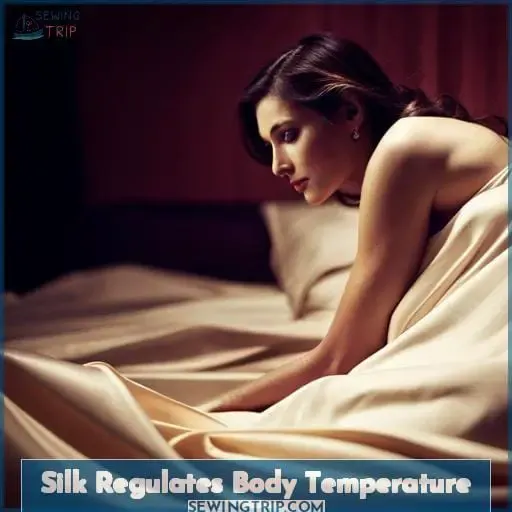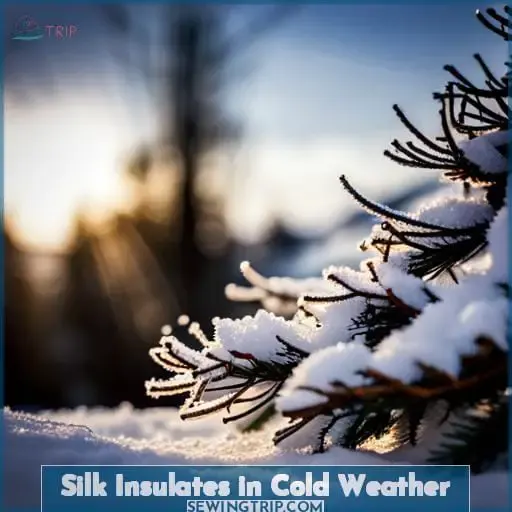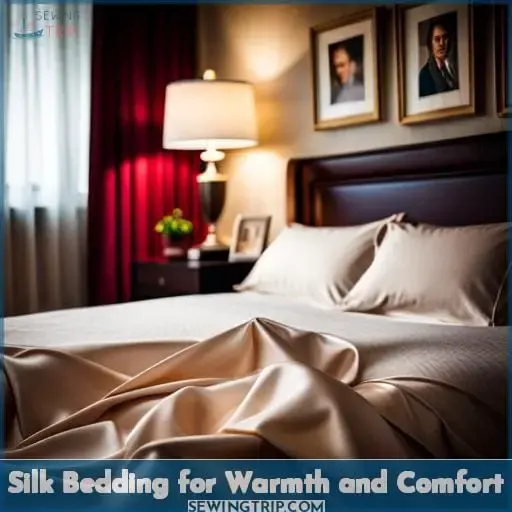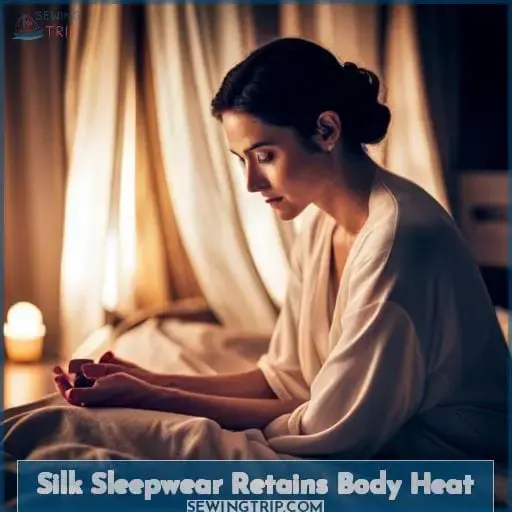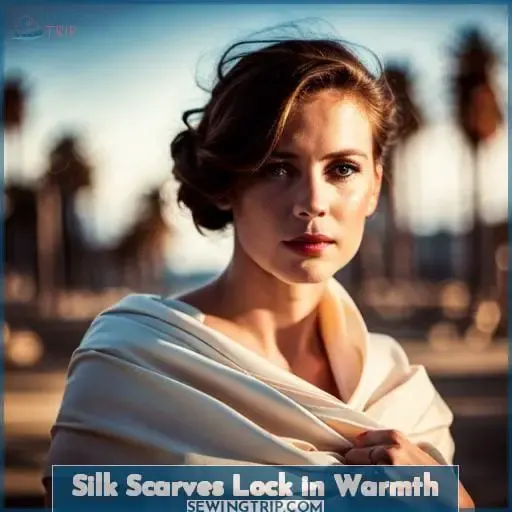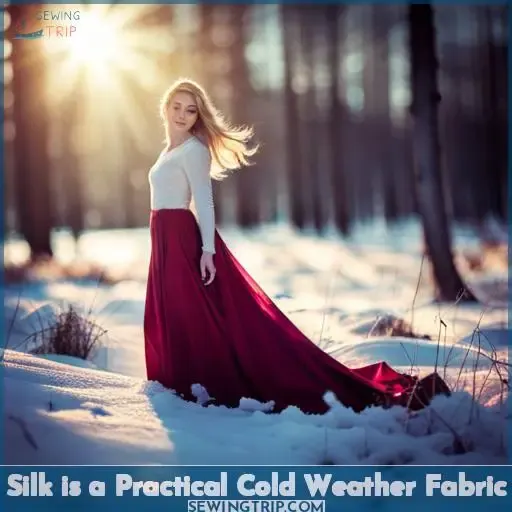This site is supported by our readers. We may earn a commission, at no cost to you, if you purchase through links.
 Let’s explore the theory that silk keeps you warm with open and understanding minds.
Let’s explore the theory that silk keeps you warm with open and understanding minds.
As textile engineers, we know fabrics have complex properties.
Silk’s lightweight feel may seem to contradict claims of warmth, but we must investigate thoroughly before judging.
Perhaps silk regulates temperature, or its smooth touch belies hidden insulation.
Approaching this topic without assumptions allows us to discover the truth with wisdom.
Now we embark on understanding silk’s secrets, that we may share knowledge and foster community.
Table Of Contents
- Key Takeaways
- Silk Regulates Body Temperature
- Silk Insulates in Cold Weather
- Silk Stays Warm Even When Wet
- Silk Bedding for Warmth and Comfort
- Silk Sleepwear Retains Body Heat
- Silk Underwear Prevents Chills
- Silk Scarves Lock in Warmth
- Silk is Historically Significant
- Silk Adapts to Hot and Cold
- Silk is a Practical Cold Weather Fabric
- Frequently Asked Questions (FAQs)
- Conclusion
Key Takeaways
- Silk creates an insulating layer, trapping warm air against the skin for warmth in cold weather.
- The natural protein fibers of silk retain warmth even when wet, providing comfort and temperature regulation.
- Silk bedding adapts to your body temperature, locking in body heat for a cozy, sweat-free night’s sleep.
- Historically worn by royalty, silk keeps you warm while maintaining its reputation for luxury across centuries and cultures.
Silk Regulates Body Temperature
As a natural protein fiber, silk syncs with your skin to create an insulating layer that helps regulate your body temperature. This insulating layer traps warm air close to your skin, keeping you warm in cold weather.
Silk is also breathable, allowing moisture to escape, so you won’t overheat when you’re active.
Silk’s thermal properties make it an ideal choice for cold-weather clothing. Silk long johns, shirts, and socks can help you stay warm even in the coldest temperatures. Silk also makes a great base layer for outdoor activities like skiing, snowboarding, and hiking.
If you’re looking for a luxurious and practical way to stay warm this winter, consider investing in some silk clothing. Silk is a natural fiber that’s gentle on your skin, and it has excellent insulating properties.
Silk Insulates in Cold Weather
However, can silk actually keep you warm when temperatures drop?
As a textile with a luxurious history, silk’s ability to insulate in cold weather showcases its adaptable charm and practicality as a winter fashion.
The natural protein fibers of silk sync with your skin to create an insulating layer of warmth, no matter how frosty it gets outside.
Like a caring embrace, silk cocoons your body, keeping precious heat close even on the most blustery days.
This elegant fabric effortlessly balances practicality with beauty, transitioning gracefully from season to season.
So while silk caresses your curves with buttery softness, it also protects you from the elements with its inherent ability to regulate body temperature.
Slip into silk this winter to experience cold weather elegance and understand why societies have treasured this fabric for millennia.
Silk Stays Warm Even When Wet
Even when you get it wet, silk retains warmth by absorbing only about 30% moisture, making it ideal if you’re an active person or outdoor enthusiast who wants comfort and free movement without sweat discomfort.
The elegance of historical silk keeps you cozy even when damp.
Wet warmth regulates your temperature on cold days.
Thermal magic protects you from the elements.
Silk provides insulation and breathability for outdoor activities, trapping a layer of warm air close to the skin. Though moisture wicks through the fabric, silk dries faster than other natural fibers like wool and cotton.
The protein structure retains heat better than other materials when wet. Whether braving winter storms or sweating through hot yoga, silk synchronizes with your skin for comfort.
Experiment with silk base layers and understand why Asian cultures treasured this fabric.
Silk Bedding for Warmth and Comfort
Why do silk sheets and pillowcases help promote quality sleep and retain body heat?
The natural protein fibers of mulberry silk bedding provide unmatched temperature regulation that adapts to your body, keeping you cozy in the winter.
As you sleep, silk forms an insulating layer, locking in body heat next to your skin.
Silk’s unparalleled breathability also wicks moisture away, keeping your bed comfortable and sweat-free.
This moisture-control promotes deeper, uninterrupted sleep cycles all night.
Additionally, the unrivaled softness of silk cradles your body gently.
Since silk is hypoallergenic, it prevents dust mites, promoting clearer breathing.
Silk’s historical status as a fabric for royalty endures today with its winter elegance.
So envelop yourself in the enveloping warmth of silk bedding this season.
Its lavish softness provides cold weather comfort that you’ll love sinking into night after night.
Silk Sleepwear Retains Body Heat
Luxurious silk sleepwear elegantly retains body heat through cold winter nights.
The natural breathability and moisture-wicking properties of silk regulate temperature, keeping you blissfully warm.
Silky pajama sets and nightgowns wrap you in thermal style, locking in heat for weather chic even on the chilliest nights.
Treat yourself to the cozy warmth of silk, and wake refreshed – never too hot or too cold.
Silk’s luxe properties ensure uninterrupted sleep all season long.
Silk Underwear Prevents Chills
Your silk underwear absorbs moisture next to skin, preventing uncomfortable chills on cold days.
Silk has natural insulation properties that help regulate body temperature in cold weather.
Breathability wicks moisture
Smooth texture prevents chafing
Natural fibers adapt to body heat
Moisture-wicking prevents clamminess
Maintains healthy skin environment
Silk undergarments provide warmth by trapping heat close to the body while allowing ventilation.
The elegance and luxury of silk also appeals during winter fashion months. As a high-end natural fabric, silk brings both beauty and practical benefits.
Silk Scarves Lock in Warmth
You can wrap silk scarves around your neck to lock in warmth when it’s cold out. Silk scarves make for chic and stylish cold-weather accessories. Their lightweight fabric may seem too delicate for frigid temps, yet silk’s natural breathability traps body heat close to your skin.
Wrap yourself in silk this winter for warmth with elegance. Drape long rectangle twilly scarves loosely around your neck and shoulders for a cozy yet glam look. Use a large silk scarf as a shawl, folding it into a triangle and tying the corners behind your neck.
Top off your outfit with a blanket scarf, wrapping the oversize silk rectangle around you like a blanket.
Silk scarves lend sophistication to any winter ensemble while keeping you snug. Their sheen adds a touch of refinement to puffy coats and casual layers alike.
Silk is Historically Significant
How long has silk been prized as an exclusive, luxurious fabric?
You’re likely aware that silk has historically been associated with royalty and the upper class.
In ancient China, silk was once exclusive to the Emperor and even used as a form of currency.
The lucrative silk trade expanded across Asia and Europe, with silk remaining an exceptionally valuable commodity that was affordable only to the wealthy.
Even today, silk is still viewed as a luxurious, high-end fabric due to its beautiful sheen, soft texture, and intricate patterns.
Silk’s historical significance stems from its rarity and labor-intensive production, as each cocoon must be cultivated and unwound by hand.
So while silk keeps you warm by adapting to your body temperature, it’s the fabric’s enduring legacy of luxury that adds to its appeal.
Silk brings to mind images of exotic trade routes, royal robes, and the indulgent lifestyles of history’s nobility.
Silk Adapts to Hot and Cold
You’ll find silk adapts to both hot and cold climates, making it a versatile choice year-round.
As a natural protein fiber, silk effortlessly regulates your body temperature.
In the winter, its smooth and insulating texture envelops you in a blanket of historical elegance, trapping air close to your skin to retain warmth even on the coldest days.
Yet its breathable weave keeps you cool in the summer, wicking moisture away.
Truly the fabric of emperors, silk lends weather elegance through the seasons – complementing your winter wardrobe with insulating grace as sublime as its storied past while transitioning effortlessly into breezy lightweight blouses or dresses when temperatures climb.
With such adaptability between heat and cold, silk remains an eternally practical and luxurious choice.
Silk is a Practical Cold Weather Fabric
Its ability to regulate body temperature makes silk a practical choice for staying warm in colder weather.
Silk’s elegance allows you to stay stylish while combatting the cold. Pair silk thermals with your favorite winter outfits.
Silk retains more heat than wool when wet, making it ideal for outdoor winter adventures.
Current silk fashion trends feature items like blanket scarves, gloves, and thermals in rich colors and patterns.
Silk’s historical association with royalty speaks to its enduring comfort and luxury.
Frequently Asked Questions (FAQs)
Does silk provide warmth when layered under other materials like wool or down?
Yes, silk provides warmth when layered, though its insulating properties are limited.
Combining silk with other fabrics like wool or down maximizes warmth, as the silk’s breathability and moisture-wicking complement fabrics better suited for insulation.
Silk alone may not suffice in very cold conditions.
How does silk compare to cashmere or other luxury fabrics for retaining warmth in cold weather?
Silk can retain some warmth, but cashmere and other luxury fabrics insulate better in cold weather.
The smooth fibers don’t trap air like cashmere’s fluffy ones.
For seriously frigid temps, pair your silk with wool, down, or fleece layers.
Is all silk equally good at regulating body temperature, or does the type of silk fiber impact performance?
All natural silk types regulate temperature well, but mulberry silk is superior.
Its exceptional breathability keeps you cool in summer yet insulates in winter.
So whether lounging or adventuring, mulberry silk adapts for year-round comfort and belonging.
Does the tightness of the silk fabric weave make a difference for trapping warm air close to the skin?
Yes, tightly woven silk fabric traps more warm air close to the skin than loosely woven silk.
The tighter the weave, the less space there is between threads for heat to escape.
However, some space is still needed for breathability.
Finding the optimal weave tightness means balancing warmth retention and comfort.
Can silk bedding or sleepwear be too warm for people who sleep hot or have night sweats?
Yes, silk sleepwear can be too warm for hot sleepers.
The breathable fabric typically provides comfort across temperatures, but those prone to night sweats should opt for pure cotton or moisture-wicking performance fabrics instead.
Silk’s insulating qualities may exacerbate existing heat issues.
Conclusion
As versatile as silk is glamorous, this regal fabric gracefully adapts from summer’s heat to winter’s chill.
Like a chameleon changing colors, silk regulates body temperature to keep you cozy yet cool.
Whether layered under wool for added insulation or wrapped alone as a stylish scarf, silk retains warmth in cold weather.
Does silk keep you warm? Absolutely – both fashionably and practically, silk is a trusted companion against the elements.
Treasure silk garments through generations, for their beauty and resilience weather every season.

